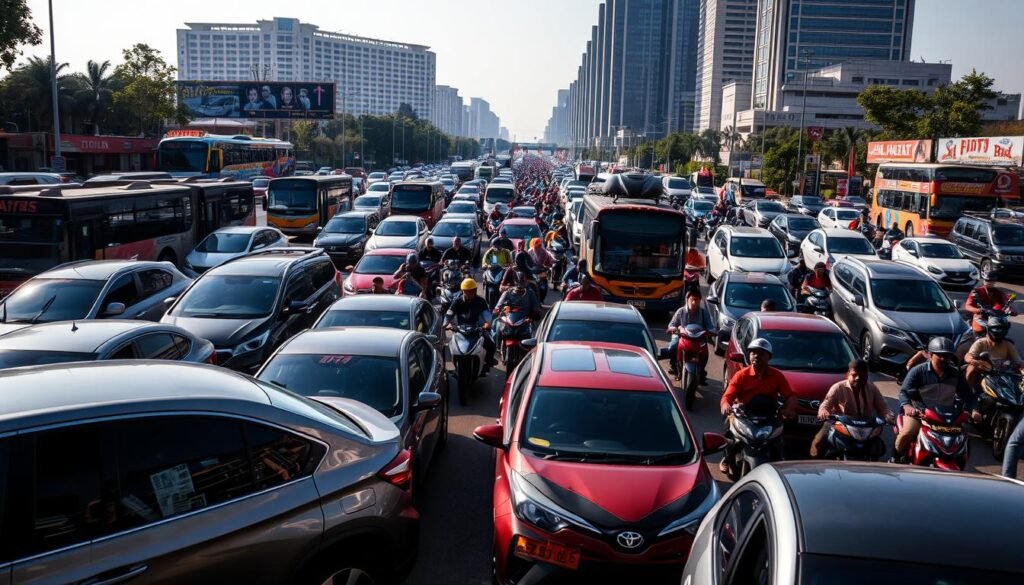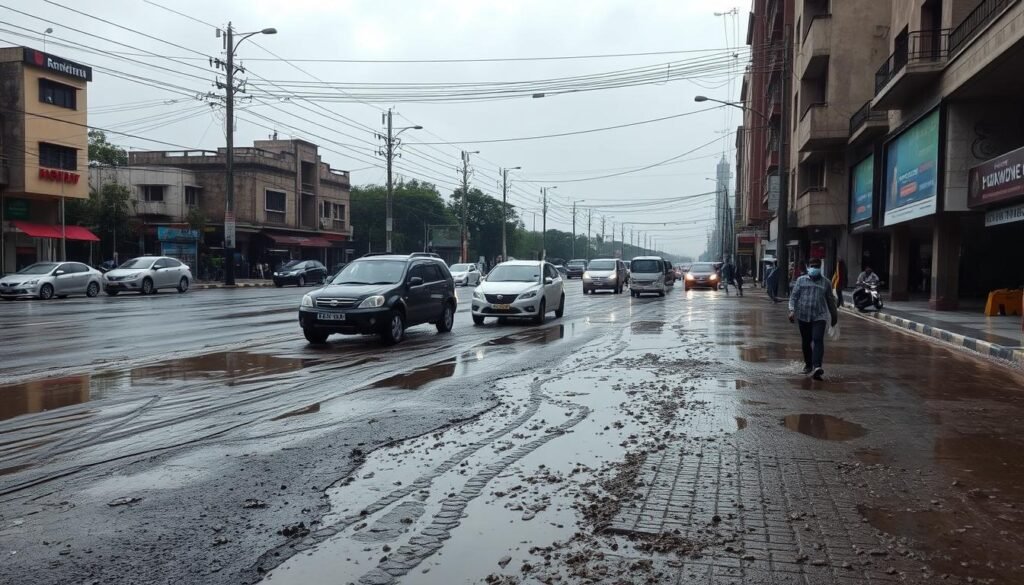Once farmland, Pune’s Rajiv Gandhi Infotech Park now hosts global giants like Microsoft—a ₹700-crore campus anchoring this thriving hub. Deputy CM Ajit Pawar’s recent warning about neglected infrastructure has sparked urgent conversations. Can upgrades match the explosive growth?
Over 70,000 professionals work here, yet roads and utilities struggle to keep pace. The PMRDA is fast-tracking Metro Line 3 and civic upgrades, but challenges remain. Villagers resist land mergers, while tech workers demand better transit.
This region stands at a pivotal moment. Will planned development transform it into a world-class tech corridor? We explore the clash between ambition and reality—and what it means for Pune’s future.
Pawar’s Viral Warning: A Wake-Up Call for Pune’s Tech Hub

Deputy CM Ajit Pawar’s sharp critique of civic neglect went viral—turning infrastructure woes into a statewide debate. His June 2024 remarks spotlighted monsoon chaos at Wipro Circle, where floodwaters stranded thousands. The pune metropolitan region’s plight suddenly dominated headlines.
Within days, 22,000 professionals signed the ‘UNCLOG’ petition, demanding fixes for traffic congestion and drainage. Cross-party leaders rallied: NCP’s Supriya Sule pushed for inter-agency coordination, while Shiv Sena’s Shrirang Barne set a pre-election merger deadline. “The development authority must act before November,” he declared.
Behind the urgency lies a nine-year stalemate. Since 2015, proposals to merge seven villages with PCMC stalled amid jurisdiction disputes. MIDC manages roads and utilities, but residents blame its fragmented oversight for chronic floods. The Wakad Residents Association issued a 60-day ultimatum: “Delays cost livelihoods.”
| Stakeholder | Demand | Status |
|---|---|---|
| NCP (Sule) | Unified metro planning | Pending PMC-PMRC talks |
| Shiv Sena (Barne) | PCMC merger by 2024 | Draft proposal circulated |
| Wakad Residents | Drainage upgrades | MIDC surveying sites |
We see a rare consensus: Pune’s tech corridor can’t thrive without systemic change. As elections near, promises must translate into diggers on the ground.
Urban Strain: Waterlogging, Congestion, and Civic Neglect

Every July, commuters face a brutal reality—what should be a 15-minute drive becomes a two-hour ordeal. The tech corridor’s infrastructure buckles under seasonal rains and relentless traffic, exposing gaps between growth and governance.
Monsoon Chaos: Chronic Waterlogging in the IT Corridor
Last monsoon, Wipro Circle turned into a lake, stranding 300 corporate buses. The Mhalunge bottleneck idles vehicles for hours, wasting 47,000 liters of fuel daily. “Our shuttles now take 12km detours,” admits an Infosys driver.
Peak-Hour Gridlock: How Traffic Strangles Productivity
At 5 PM, tech park exits merge into single-lane chaos. A Cognizant manager shares:
“Productivity drops 40% since 2022—employees spend more time in cars than meetings.”
PMRDA’s Skyway plans promise relief, but today’s missing links to the Mumbai-Bangalore Bypass forcepeak hoursinto paralysis.
While the Metro Line 3 aims to ease transport woes, current failures cost industries ₹22 crore monthly in delayed logistics. The clock is ticking for solutions.
Infrastructure Solutions: Metro Line 3 and the Skyway Promise
The race to modernize Pune’s transit network hinges on two critical projects: Metro Line 3 and the Skyway. Together, they aim to untangle the region’s notorious traffic congestion—but delays and design disputes cloud their potential.
Metro Line 3 Progress: Will It Ease the Commute Crisis?
Construction crews work round-the-clock on the 8.5km elevated corridor linking Balewadi to Rajiv Gandhi Park. Slated for a 2025 launch, the line could cut travel time by 70% for 50,000 daily riders. Yet, forest clearances remain pending, and Viman Nagar residents filed lawsuits over noise pollution risks.
Commuters demand real-time app integrations with Metro schedules. “We need live updates to plan transfers,” says a Wipro employee. The development authority promises Wi-Fi-enabled stations, but critics question cost overruns.
The New Skyway: Bridging Gaps or Adding Complexity?
PMRDA’s Skyway faces its own hurdles. Kumar Builders revised SEZ blueprints after alignment shifts near Tathawade. Environmentalists warn the route threatens aquifers, while planners defend its decongestion benefits.
- Junction conflicts: Skyway’s merge with Mumbai-Bangalore Bypass requires a redesign, risking delays.
- Stakeholder pushback: Residents near proposed exits fear increased noise and land value drops.
- Promises vs. reality: PMRDA claims 40% fewer vehicles on roads, but skeptics cite unchecked urban sprawl.
As cranes dot the skyline, Pune’s mobility future hangs in the balance—between steel-and-concrete ambitions and ground-level realities.
Policy Response: Multi-Agency Efforts to Unclog Growth
Policy makers are scrambling to address infrastructure gaps that threaten Pune’s economic momentum. The PMRDA’s fast-track projects and the long-pending PCMC merger now dominate discussions—each promising solutions but facing fierce resistance.
PMRDA’s Fast-Track Push: Promises vs. Ground Reality
The development authority pledges to complete Metro Line 3 by 2025, yet land acquisition delays persist. A recent audit revealed only 40% of drainage upgrades are done—despite monsoon deadlines. “We’re caught between red tape and public demand,” admits a PMRDA engineer.
Tax revenue disputes further complicate progress. MIDC and gram panchayats clash over funds, while PCMC eyes control of the industrial area:
| Stakeholder | Tax Claim (%) | Service Responsibility |
|---|---|---|
| MIDC | 62 | Roads, utilities |
| Gram Panchayat | 23 | Local sanitation |
| PCMC (Proposed) | 15 | Transit, zoning |
The Merger Debate: A Fight for Integration
Sarpanch Jambhulkar’s 7,000-signature petition reflects villager fears:
“Our land will become parking lots for tech parks.”
Yet, 22,000 IT workers could gain voting rights if the merger passes—shifting political power.
The Bhosari industrial belt’s 2018 merger offers a precedent. Unified governance cut permit delays by 60%, but displaced farmers protested for years. As the state weighs approval, residents brace for change—whether evolution or erosion.
Investor Outlook: Real Estate Boom Amid Infrastructure Woes
Skyrocketing rents near tech hubs reveal a stark divide between housing demand and civic readiness. While infrastructure struggles, property values surge—Wakad apartments now command 40% premiums near proposed Metro stations. Investors see long-term potential where residents face daily gridlock.
Megapolis and Beyond: Township Expansions Reshaping Demand
Kumar Properties reports an 18-month waitlist for walkable office units at Megapolis. This 125-acre township exemplifies the “live-work-play” shift:
- New shuttle routes cut time to EON IT Park by 55%
- Balewadi Stadium area sees 1BHK rents jump 33% in 2024
- MIDC’s land lease reforms may unlock 300+ acres for mixed-use projects
A PropTiger report notes:
“The 15-minute commute radius now stretches west, with Ravet offering savings—but fuel costs erase them.”
Rental Dynamics: How Connectivity Dictates Housing Trends
Tech couples face tough math: ₹35,000 Wakad rents versus ₹18,000 in Ravet plus ₹9,000 monthly fuel. Connectivity drives decisions, as one TCS employee explains: “Two hours daily in traffic steals family work life balance.”
The map is redrawing itself. As Skyway and Metro links progress, locality premiums will intensify—placing pressure on planners to deliver promised upgrades.
Hinjewadi’s Dilemma: Evolution or Erosion Under Success?
Two futures emerge: a seamless tech hub or perpetual gridlock. With IBM’s 205-acre SEZ approval and an $80B GDP projection by 2028, the region’s growth is undeniable. Yet, PMRDA’s infrastructure sprint clashes with 9% annual vehicle increases.
Microsoft’s new campus plans spark optimism, but activists warn of monsoon floods. We envision balanced development—unified governance, green mobility, and affordable housing. Without these, opportunities risk drowning in challenges.
As Anjali Rao, a tech worker, urges: “Fix basics before chasing grandeur.” The choice is clear—build smarter, or brace for stagnation.




